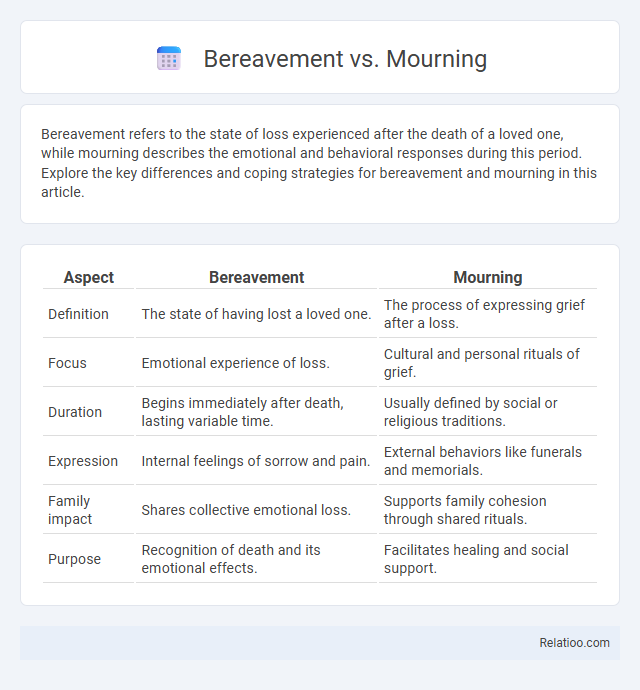Bereavement refers to the state of loss experienced after the death of a loved one, while mourning describes the emotional and behavioral responses during this period. Explore the key differences and coping strategies for bereavement and mourning in this article.
Table of Comparison
| Aspect | Bereavement | Mourning |
|---|---|---|
| Definition | The state of having lost a loved one. | The process of expressing grief after a loss. |
| Focus | Emotional experience of loss. | Cultural and personal rituals of grief. |
| Duration | Begins immediately after death, lasting variable time. | Usually defined by social or religious traditions. |
| Expression | Internal feelings of sorrow and pain. | External behaviors like funerals and memorials. |
| Family impact | Shares collective emotional loss. | Supports family cohesion through shared rituals. |
| Purpose | Recognition of death and its emotional effects. | Facilitates healing and social support. |
Understanding Bereavement and Mourning
Bereavement refers to the state of loss experienced after the death of a loved one, encompassing emotional, psychological, and social responses. Mourning is the outward expression of grief, involving rituals, customs, and behaviors that help individuals process and cope with bereavement. Understanding bereavement and mourning highlights the distinction between the internal experience of loss and the culturally shaped ways people express and manage that experience.
Defining Bereavement: The Experience of Loss
Bereavement refers to the state of having lost someone significant, encompassing the emotional, physical, and social reactions triggered by that loss. Your experience of bereavement includes intense feelings of grief, shock, and adjustment as you navigate life without the deceased loved one. It differs from mourning, which involves the outward expressions and rituals performed to honor and remember the person who has passed.
What Is Mourning? Cultural and Emotional Responses
Mourning refers to the culturally shaped and personal emotional response to loss, characterized by rituals, expressions of grief, and social behaviors that help individuals process bereavement. Different societies exhibit unique mourning customs, such as wearing black attire, holding memorial services, or observing specific periods of silence, which facilitate collective and individual healing. Emotional responses during mourning include sadness, yearning, and reflection, serving as essential mechanisms for adapting to the absence of a loved one.
Key Differences Between Bereavement and Mourning
Bereavement refers to the objective experience of losing a loved one, encompassing the event and its aftermath, while mourning involves the personal and cultural expressions of grief, including rituals and emotional processes. Your understanding of bereavement highlights the factual aspect of loss, whereas mourning emphasizes coping mechanisms and social behaviors during that period. Recognizing these distinctions helps in identifying appropriate support strategies and emotional processing during times of loss.
Psychological Impact of Bereavement
Bereavement refers to the state of having lost a loved one, while mourning is the outward expression of grief through cultural or personal rituals. The psychological impact of bereavement can include intense emotional distress, depression, anxiety, and difficulties in daily functioning. Understanding your unique mourning process can aid in managing these psychological effects and promote healing over time.
Mourning Practices Across Cultures
Mourning practices across cultures vary widely, reflecting diverse beliefs and rituals surrounding death and loss. In many Asian cultures, such as in Japan and China, elaborate ceremonies including chanting, incense offerings, and family gatherings honor the deceased and support the transition of the soul. African cultures often incorporate vibrant ceremonies, drumming, and communal participation to celebrate life and facilitate collective healing during the mourning process.
Stages of Grief in Bereavement and Mourning
Bereavement refers to the objective experience of losing a loved one, while mourning encompasses the cultural and external expressions of grief. The stages of grief in both bereavement and mourning typically include denial, anger, bargaining, depression, and acceptance, as identified by the Kubler-Ross model. These stages help individuals process emotional pain and gradually adapt to life after loss.
Supporting Someone Through Bereavement vs Mourning
Supporting someone through bereavement involves offering emotional stability and practical help during the initial loss phase, while mourning encompasses the personal and cultural expressions of grief over time. Bereavement support prioritizes listening, validating feelings, and providing resources for coping strategies, whereas mourning support respects individual rituals and ongoing adjustments. Understanding the distinct processes enables tailored empathy that honors both immediate and prolonged experiences of loss.
Coping Strategies for Bereavement and Mourning
Coping strategies for bereavement and mourning involve active psychological and emotional adjustments to loss that affect your mental and physical health. Bereavement coping includes seeking social support, engaging in grief counseling, and establishing new routines to restore a sense of normalcy. Mourning strategies emphasize personal rituals and cultural practices that help express grief and facilitate emotional healing, providing a structured path toward acceptance.
When to Seek Help: Complicated Grief and Prolonged Mourning
Bereavement is the state of experiencing loss, while mourning refers to the outward expression and process of grieving. When grief extends beyond six months to a year with intense, disabling emotions, it may indicate complicated grief, requiring professional help to prevent prolonged mourning. Seeking support from mental health specialists ensures proper coping strategies and reduces the risk of persistent emotional distress.

Infographic: Bereavement vs Mourning
 relatioo.com
relatioo.com